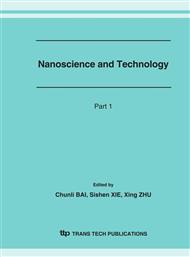p.713
p.717
p.721
p.725
p.731
p.735
p.739
p.743
p.747
SAMs-Drected Metallization and Its Application in Fabrication of Core-Shell Nanocomposites
Abstract:
Molecular assembly technology has attracted much research attention due to its flexible applications in modulation of surface property and construction of nanostructures and devices. Herein, a well-defined surface metallization technique has been achieved via anchoring electroless catalysts onto substrates’ surfaces with the pendant active groups of self-assembled monolayers. This method affords a means to control surface functionality at molecular level and has advantages over the conventional Sn-Pd methods, such as convenient operation, good reproducibility, increased longevity of the activated initiator and improved adhesion of metal deposition to substrates. Therefore, it has great significance in the fields of developing bottom-up combined micro/nano-fabrication technique. This metallization process has been successfully performed on hollow ceramic particles to fabricate light-weighted core-shell functional materials.
Info:
Periodical:
Pages:
731-734
Citation:
Online since:
March 2007
Authors:
Keywords:
Price:
Сopyright:
© 2007 Trans Tech Publications Ltd. All Rights Reserved
Share:
Citation:


